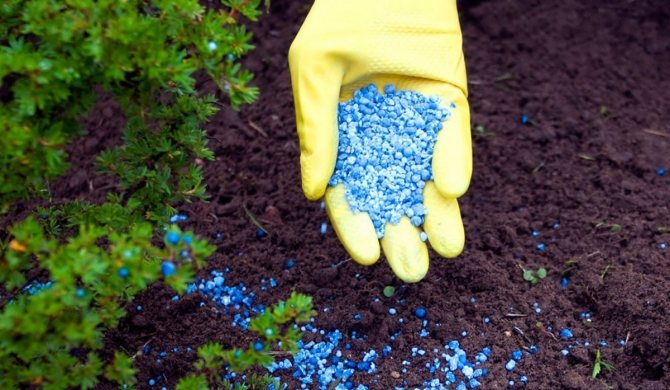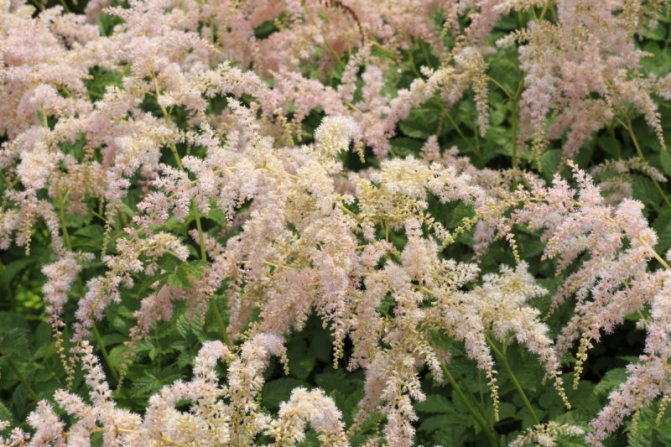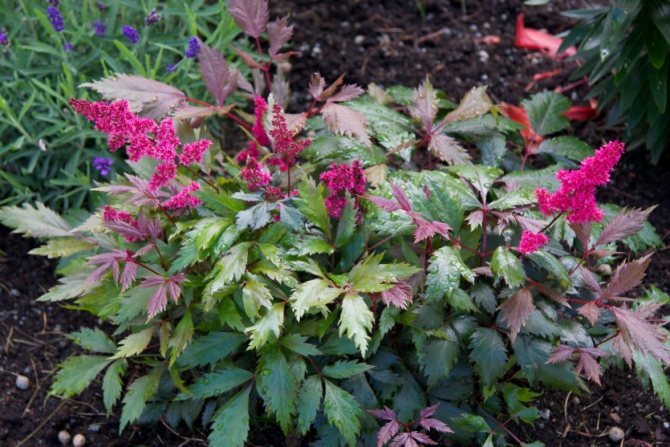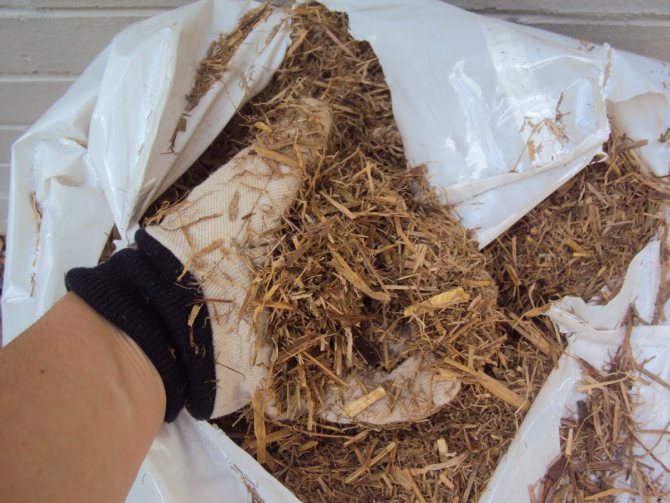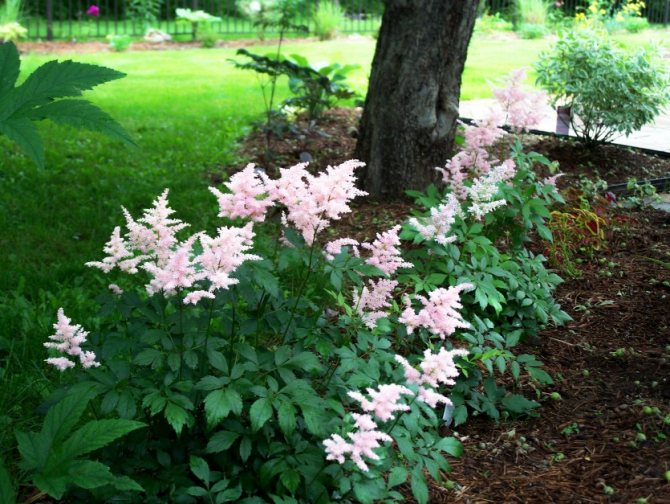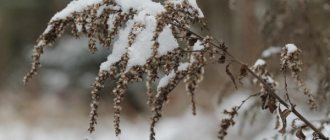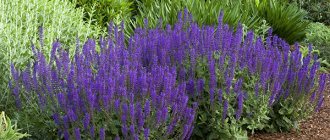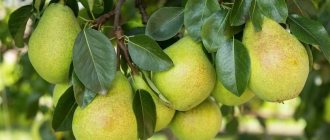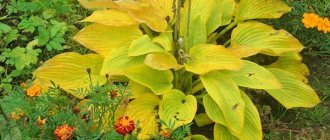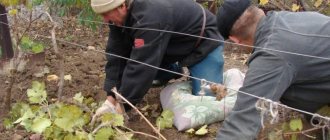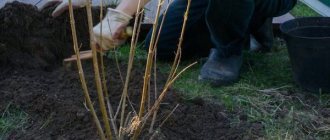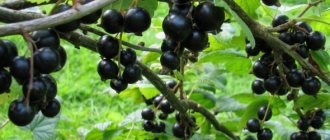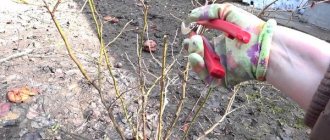Astilba is a beautiful perennial herb that invariably delights with the delicate beauty of its fluffy Christmas trees, inflorescences and lace leaves. It fills the garden with a sweet honey aroma and helps to immerse oneself in the world of tenderness and magic. In natural conditions, the queen of the shady garden is found in mountainous regions where the climate is monsoon, even at an altitude of almost 5000 meters. Therefore, this perennial is very hardy and frost-resistant enough, and it will be quite comfortable in various regions of our country, where the winters are quite cold.
How to properly care for this perennial in the fall, what should be done to prepare it for winter? All this will be discussed below.
How to prepare a flower for winter
Preparing a flower crop such as astilba for winter includes pruning, mulching, fertilizing.
Do I need to cut the plant for the winter
Pruning this crop for the winter, in most cases, must be done for several reasons:
- Seeds ripening in capsules on dried paniculate inflorescences take away a large amount of nutrients, thereby weakening the plant.
- The leaves damaged by the first frosts will still die off, while creating conditions for the development of diseases and wintering of pests.
- On bushes more than 5 years old, as well as in a harsh climate, it is necessary to cut off the aerial part in order to most effectively and reliably cover the plant from frost and cold using various covering materials, plastic wrap.
Also, pruning allows you to give the plant gradually shedding foliage more neat and well-groomed appearance.
Timing
Pruning includes the removal of flower stalks with faded paniculate inflorescences and frost-damaged foliage that has begun to dry out. Peduncles with panicles are removed after flowering, as soon as the petals begin to fall off the inflorescence, and it becomes yellow-brown in color. Depending on the characteristics of the variety, this part of the pruning is performed in July-August. The foliage is cut in the fall, when the first night frosts come - October-November.
Pruning rules
The pruning technology of this flower crop includes the following steps:
- Faded and brown inflorescences are completely removed along with the peduncles.
- The foliage is cut at the very surface of the earth. In this case, the remaining stumps should protrude above the soil surface by no more than 15-20 millimeters.
Pruning is carried out with pruning shears or sharp scissors previously disinfected in a 1% solution of potassium permanganate. Autumn pruning of this culture is not carried out when it is planted at this time - in such cases, the annual astilbe bush is cut off only next fall.
Mulching
After pruning, the soil around the plant is carefully loosened to a depth of 10-12 centimeters and covered with a 5-6 centimeter layer of mulch. Well-rotted compost, humus, straw, dry grass, low-lying peat are used as mulching materials.
It is undesirable to use fresh oak sawdust, wet and decaying foliage, any polymeric materials that do not allow air to pass through as mulch.
Fertilizer
Autumn feeding is necessary to strengthen the plant and overwinter it well.It is performed with phosphorus and potassium fertilizers in a dose of 20 grams of each active ingredient. In physical weight, this is about 40 grams of potassium sulfate and 50 grams of double superphosphate.
These fertilizers are applied in two ways:
- In dry form - randomly, when loosening the soil before or after trimming the aboveground part of the plant, with the obligatory embedding to a depth of 10-12 centimeters.
- In the form of a solution - with water-charging autumn irrigation.
When introduced in the form of a solution, superphosphate is preliminarily dissolved in boiling water, and then mixed with potassium sulfate diluted in cold water.
Autumn dressing
After the end of flowering, astilbe continues its growing season: its aboveground part remains green, photosynthesis and all other life processes continue. However, flowering takes away from the plant a huge amount of nutrient resources, the supply of which must be replenished as quickly as possible. Nutrient deficiencies are exacerbated by the longevity of astilba, which does not require transplanting for 5-20 years. For such a long period, the bushes draw out all available nutrients from the root zone of the soil.
In this regard, annually in the fall, astilba experiences an urgent need to replenish the resources of the nourishing substrate.
Among the suitable dressings for representatives of this species stand out:
- mineral fertilizers containing potassium and phosphorus: a mixture of potassium magnesium and superphosphate can be applied in bulk granules (20-25 g each) in a half-meter radius from each bush;
- organic nutrients: wood ash (100 g / 1 m²), bone meal (2 tablespoons / 1 m²) and rotted compost / humus (10 l / 1 m²).
The added minerals will help keep the roots from cold temperatures and provide a supply of inorganic nutrients needed for foliage to grow and develop in spring.
Shelter of astilba for wintering
Young bushes after timely pruning and mulching in a temperate climate do not need shelter. Starting from the age of 5, when the overgrown rhizome already protrudes strongly above the soil surface, the plant needs mandatory shelter.
The simplest, but at the same time reliable, shelter for a given culture is done as follows:
- Having retreated from the rhizome about 10-15 centimeters, 4 wooden bars are stuck next to the plant.
- The bars are tied together with planks.
- Dry foliage is poured inside the resulting frame.
- The frame with foliage is covered with a non-woven porous material - lutrasil.
- A dense and thick plastic film is placed on top of the lutrasil, pressing its edges with bricks, stones or sprinkling with earth.
Such a shelter will protect the rhizome with buds from freezing during the winter, protect the plant from damage by rodents.
What are the features of the preparation of astilba in different regions
Depending on the conditions of the region in which the culture winters, there are some peculiarities in its preparation for the winter season.
In the Urals and Siberia
In the conditions of Siberian harsh winters, plants of this species at any age must be covered for the winter after pruning. For this, large frames are erected above them, or they are simply covered on top with a large layer of spruce branches and straw. Also, often in such conditions, astilbe is grown in large pots, which, with the onset of the first frost, are brought into dry and cool rooms for the winter, where they can be guaranteed to be stored in winter.
Garden decoration with blooming astilba
Tall, colorful shrubs are always popular in garden design. Astilbe looks great with deciduous plants such as hosts and ferns. Long leaves of neighboring crops protect from drying out of the soil and direct sunlight.
Astilba inflorescence looks beautiful in group planting.Also, the plant feels great and harmonizes near water bodies.
Snowdrops will be an excellent combination with astilba leaves blooming in May. The perennial grows just as well with conifers.
Beautiful lush inflorescences can decorate the landscape of any site.
Typical mistakes when preparing for the winter period
The main, most common mistakes made by flower growers when preparing astilba for winter are the following:
- Incomplete pruning - many growers do not cut off faded inflorescences, as a result of which the plant is greatly weakened, giving a very large amount of nutrients to seed formation.
- Neglect of phosphorus-potassium fertilizing - in the absence of such an event as the introduction of phosphorus and potash fertilizers under the culture, astilbe leaves in winter insufficiently strong. This, in the case of extreme cold weather and insufficient insulation, can play a fatal role.
- Poor mulching - a small layer of mulch can lead to the fact that in the event of even slight frosts, the soil near the plant will freeze more intensively, causing damage or complete death of the rhizome.
Also in areas with severe winters and when the plant is more than 5 years old, the most serious mistake is poor insulation of the bush, leading to its damage or complete death..
Astilba is an amazing plant that is gaining more and more space for its beauty in gardens and flower beds. One of the indisputable advantages is the abundance of varieties. The shrub does not need continuous active care. But still, this does not mean that astilbe does not need care in the fall, preparation for winter, pruning or additional shelter. Novice gardeners are concerned about whether it is necessary to make a full cut or cover the plant, whether it is frost-resistant. All this must be learned before planting a shrub. With the help of this information, you can avoid problems in the future and organize proper timely care.
Shelter for the winter
Most often, coniferous branches are used as a natural shelter for plants.
Preparing Astilba for winter has several nuances that are important to consider:
- not all bushes require additional shelter, but only those that are most vulnerable due to their age; the rest can only be cut, weeded, fed and covered with mulch;
- it is important to ensure that the area with planted astilbe is not flooded, as this is fraught with rotting of the rhizomes;
- to insulate bushes over 5 years old and protect rhizomes from glaciation after an unexpected thaw, pine spruce branches, geotextile fabric, lutrasil or agrofibre are used;
- in case of expectation of severe frosts, you can build an additional fence made of boards around the bush, inside which dry earth and fallen leaves are poured.
What is special about caring for astilba in autumn
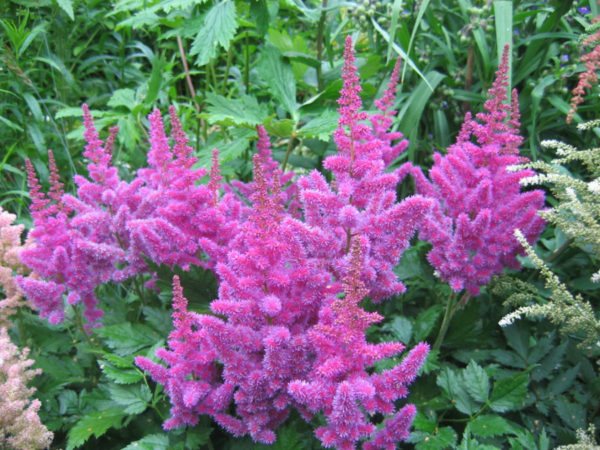
Astilba is a plant that has lived for a couple of decades. It is hardy, it survives cold weather well. Therefore, there is often a desire to do nothing at all. But in the first year, the shrub needs special care. To make it stronger, the peduncles are immediately cut off. Then all the beneficial substances will not go to flowering, but will go to the development of roots. The soil must be loosened to ensure regular air exchange, watered. Near young plants, all weeds are removed, but the overgrown astilba itself then pushes them out.
Shrubs that are 5-6 years old also require care. By this time, the roots are already actively growing, their sensitivity to cold increases. Therefore, the soil near the bush is not only mulched, but also covered with non-woven material.
The whole process of caring for astilba in autumn and preparing a flower for wintering consists of three stages:
- Top dressing.
- Pruning flower stalks and dry stems.
- Covering the soil with mulch and cloth.
Features of wintering astilba in the open field
The plant is highly frost-resistant.Because of this, many growers make a serious mistake by not taking any action. In fact, you need comprehensive care for astilba in the fall in preparation for winter.
The main reason this procedure is required is that the plant is not intended to be grown in flower beds and gardens. Astilba is a perennial found in mountainous regions at an altitude of up to 5 thousand meters. The bush is resistant to these conditions, but may suffer from factors to which it has not previously been adapted.
Important! Special care is required in the first year after planting in open ground. During this period, astilba has not yet matured and may suffer from frost or strong winds.
Preparation for winter includes a set of activities. It is necessary to consider the main stages of this procedure.
Pruning astilba in the fall
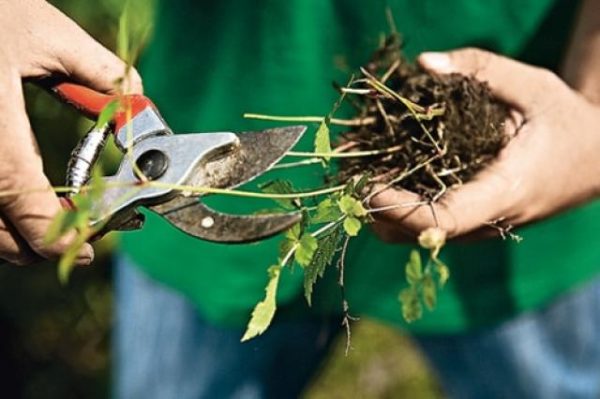

Different varieties of shrubs bloom at different times from about early summer to autumn. You can cut off faded buds not immediately, but a little later, because dry flowers also look beautiful, creating the illusion of prolonged flowering.
For pruning, gardeners use an ordinary garden pruner, which is previously disinfected in a solution of potassium permanganate. It so happens that one shrub is infected with a disease, and to prevent the transfer of bacteria to the rest, the tool is disinfected after each pruning procedure.
Why cut astilbe in the fall


Prune the astilbe before planting the seeds. The flower spends too much energy on this, which could be directed to strengthening the roots and accumulating nutrients. Some growers prune wilted flowers immediately, some leave them longer. But after the first frost, the peduncles and stems are cut off almost to the full length, because it is easier to shelter the shrub from frost this way.
For novice gardeners, the question arises when it is better to remove stems and leaves: in spring or autumn. Usually flower stalks and stems are removed in autumn. But, if the astilbe does not need to be covered for the winter, then you can cut the stems in the spring.
When to trim astilbe
The pruning date varies depending on the area in which the flower grows and the variety. Stems begin to be removed after the onset of frost, and in different parts of the country it gets colder in different months. On average, astilbe stems are cut from early October to mid-November.
How to properly trim astilbe in the fall
Inexperienced gardeners are afraid to cut the stems too deep and leave stumps 20 cm high. Such long cuttings are difficult to cover for the winter, and it does not look very neat. Therefore, they are removed strictly at the root, but so as not to affect the buds, which are formed just above the soil in the root part. After that, the bush is sprinkled, sprinkled with a layer of mulch. Pruning is desirable to be carried out annually, at about the same time.
Pruning
It is imperative to prune wilted inflorescences, because if left on the bush, they become the basis for the formation of numerous seeds, the process of which draws out the entire supply of nutrients from the bush. At the end of flowering, astilba must prepare for the winter cold and direct available resources to strengthen the roots.
It is contraindicated to cut off yellowing gradually dying leaves on healthy bushes. Until the very frost, the photosynthetic plates of astilba function and interact with the organs of the suction system. Temperature conditions below 0 ° C inhibit and stop the circulation of sap along the stem and leaves. However, it is better not to remove even wilted leaves, because they can form a natural antifreeze protection of the flower bed and, as a result of decomposition, return the mineral substances spent on their formation to the soil.
The ban on cutting leaves does not apply to astilbe, the plates of which are affected by pests and pathogenic microbes.
Sick astilba should be pruned.Illustration for this article is used under a standard license.
The system of measures for preparing a sick Astilba for the winter includes the following procedures:
- during the period of moderately warm autumn weather, the treatment of the plant with insecticides and medicines to eliminate the problem;
- trimming leaves after frosting their plates while preserving hemp, towering 10-15 cm above the soil surface;
- autumn treatment.
Left hemp in winter will play a snow-retention role, protecting the root system from severe frosts.
Astilba's shelter in winter
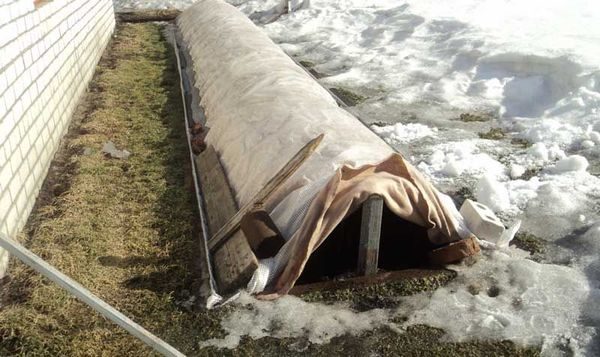

In the southern regions of the country, the cultivation of these bushes is associated with less difficulties. There is no need to cover Astilba for the winter, because even the overgrown roots are warm. Winters in the south are warm and the plant feels comfortable under these conditions. But in areas where winters are harsh, cold or snowless, shrubs need protection from frost. Therefore, there the astilba must be covered.
Is it necessary to cover astilba in the winter
Astilbe is classified as a plant that tolerates low temperatures well down to -25 ° C. The aboveground parts of the bush will survive the cold winter, but the roots are more likely to suffer. The roots of plants over 5 years old are especially sensitive. They grow close to the soil surface and freeze if not covered. Together with the roots, the kidneys may suffer from the cold. Which will lead to a rare and slow blooming of buds. Therefore, covering the astilba is just as important as cutting off its stems.
We cover the shrub correctly
Young, only planted plants are less of a hassle. Growers spud the cut shrubs and cover the soil around the roots with a thin layer of mulch. Mature plants need to be covered more carefully. Especially if the winters are cold and there is very little snow, or if the next frost occurs after the spring thaw. In these cases, gardeners form a fence with boards, sticks, stones or bricks. A layer of textile material is applied on top, its edges are pressed with stones so that they are not blown away by the wind.
Landing astilba
It is generally accepted that astilba - plant for partial shade
, not fond of open and sunny places. This is due to the fact that astilba does not tolerate drought and overheating of the rhizome. But if in hot weather it is watered every day, and the root outlet is mulched, then it feels great in the sun. Its flowering will be more lush and luxurious than in the shade, however, less long, however, like most other perennials.
Astilba prefers nutritious, loose and moist soils. In one place, astilbe can grow up to 10 years, therefore, you need to approach its planting seriously. Where it is planned to plant astilba, they dig up the soil, remove all roots and weeds, make holes 30 centimeters in depth and width. 20-25 g of superphosphate, a handful of wood ash and half a bucket of humus or compost are poured into each hole. Everything is thoroughly mixed with a part of the garden soil dug from the hole, the astilbe cuttings are planted and watered well. The topsoil at the roots of astilba should be constantly loose and moist.
In the first year of planting, you do not need to do any more fertilizing, only mulching the soil. When growing astilba, perhaps, cannot be overemphasized humus or compost in the form of mulch
... But sawdust, crushed bark or grass can also be used as mulch.
During the growing season, you need to constantly weed the grass around the astilba, because the roots of some weeds, for example, weeds, entwine the rhizome of astilba and oppress.
Pre-winter preparation of astilba in different climatic conditions


Since the regions of Russia differ in climatic conditions, astilba requires different preparations for winter, depending on the habitat. In some areas it is enough to cover the shrub with a layer of mulch, while in others it will not save the plant from freezing.
- Middle lane. If a not too frosty, but snowy winter is expected in the Moscow region, the soil near the bush is only mulched. Sometimes they cover the plant with pine spruce branches, straw or other material, a cloth that provides access to fresh air. Thanks to this, the soil does not loosen under the cover layer.
- Volga region. In the Volga region, the winter time is quite warm, so you can limit yourself to the same actions as for the middle zone.
- Ural and Siberia. Winters are very harsh in these regions, so a layer of mulch will not be enough. The Ural and Siberian land sometimes freezes up to a meter deep. Therefore, a frame is built around the trimmed bush, on which air-permeable material is hung.
Mulching
Astilba has a fairly high frost resistance. The plant successfully withstands the winters of the Middle Lane without an additional protective layer. However, a harsh and little snow cold period can be potentially dangerous for the bush. Therefore, in order to reduce the existing level of risk, it is necessary to organize astilbe protection from branches of spruce branches and snow thrown on them.
Fragile young bushes of 1-2 years of age and old astilbe, the roots of the first order of which often find themselves on the surface of the soil, are especially in need of additional shelter, and therefore are prone to freezing. Total protection for wintering plants can be provided by mulching the trunk circle with a layer of humus, compost or peat. This mulch will be a source of additional organic food.
Astilba transplant in the fall
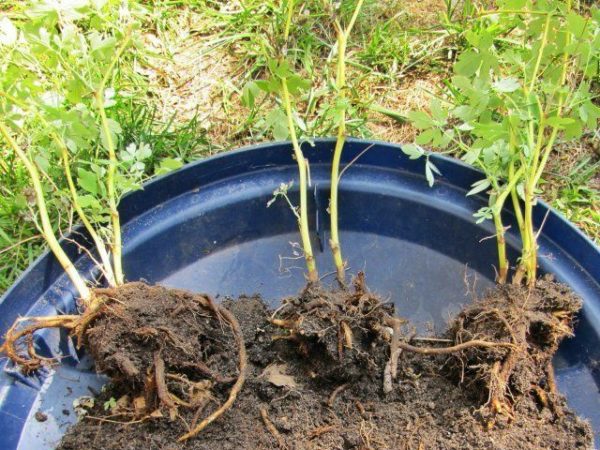

The astilba bush needs constant moisture, so experienced flower growers recommend replanting the plant after flowering. At the beginning of September or at the end of August, the sun is no longer so active, and there is enough moisture.
The shrub is transplanted in order to achieve a denser flowering. Mature astilba does not look so attractive, and the roots growing upward are exposed to extreme cold. With the help of a transplant, it is revived. This should be done every 4 years.
It is imperative to use a sharp knife when dividing the shrub so as not to harm the plant. The entire root system is usually cut into several parts so that in each new bush there are 3 intact buds. The roots are placed in a container with water so that the plants begin to develop independently and give fresh growth.
When planting, experienced flower growers leave a distance of half a meter between the bushes. Astilba needs to grow, and leaves and branches need space. The depth to plant is determined by the kidneys. They should be about 4-5 cm above soil level. After that, a thin layer of mulch of about 2 cm is covered.This will help to retain moisture and avoid weeds.
Growing astilba
Growing is not a big deal. A fairly unpretentious plant that loves shaded places with constantly moist soil. Planting time is end of March - May. Before planting, you need to dig up the land, remove weeds and add compost or humus to it, at the rate of: 2 buckets of fertilizer per 1 m2. It is best to plant astilba on the north side of the house, in the shade. Some varieties, however, have adapted to live in sunny places. Flowering in these varieties is plentiful, but short. Astilbe will still bloom longer, growing in shade: under the crown of trees and shrubs, near the pool is generally an ideal place, since astilbe loves moisture. Loamy soil with an acidity of pH 5.5-6.5 is suitable for planting.
Common mistakes in autumn astilba care
Astilba is a frost-resistant plant, based on this, inexperienced flower growers make mistakes when preparing a bush for wintering and during autumn care. With the wrong care, the shrub blooms less and less, and then dies altogether. You need to be aware of the most common mistakes:
- Lack of fertilizers in autumn.
- Incorrect pruning of astilba in the fall (or its complete absence).
- Lack of mulch or additional shrub cover.
Features of caring for astilba in autumn and in preparation for winter
As you already understood, this perennial is distinguished by its hardiness and good resistance to frost, so there is a temptation to do nothing at all in the fall. So what activities should still be carried out in the autumn months in order to properly prepare astilba for the cold season?
This flowering plant is especially in need of care. in the first year after planting... In order for a young bush to get stronger and perfectly endure the winter, you should not let its buds bloom in the first season. Therefore, peduncles should be removed immediately, even before the formation of inflorescences on them. In this case, all nutrients will go to the active growth of the root system.
The soil around the young Astilba follows water and loosen regularlyso that more oxygen flows to the roots (better air exchange). At the same time, do not forget to remove weeds that prevent young plants from developing. When the shrub grows, it will push out all the weeds by itself, and there will be no need to fight them.
By the way! About, how to properly plant and care for astilba. read more in this article.
Plants that are more than 5 years old are especially sensitive to autumn care - their rhizomes grow strongly (including upward) and become more sensitive to cold if there is little snow (or no snow at all) in winter. In this case, you just need to not only mulch the trunk circle, but also cover the plant with non-woven material (lutrasil, spunbond) or spruce branches so that the root system does not exactly suffer from severe frosts.
Important! In autumn, astilba can also be propagated and transplanted by dividing the bush. This is especially true for bushes over 5 years old.
Thus, in the fall, caring for this perennial is reduced to carrying out the following procedures:
- top dressing;
- pruning peduncles and dried stems;
- mulching the soil around the plant - a shelter for the winter.
You should dwell on each of these procedures in more detail so that amateur gardeners who want to grow this flower on their site can admire its active flowering every year.
Autumn feeding
In the autumn (after flowering), you should definitely take care of applying fertilizers under each astilbe bush.
Important! You should know that organic fertilizers applied in the autumn will decompose completely only by the spring. Therefore, all the nutrients obtained in the process of their decomposition will be delivered to the plant only when it starts growing in the spring.
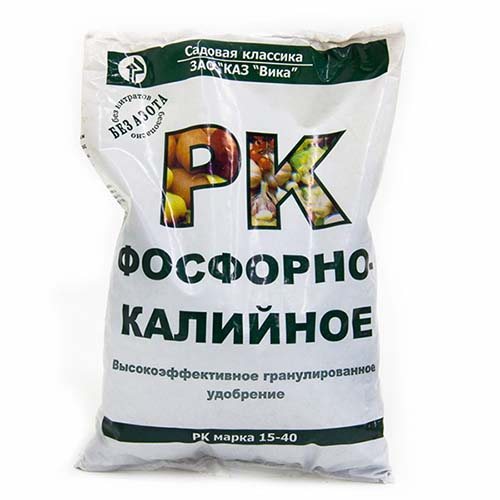

To feed astilba in the fall (after flowering), fertilizer containing potassium and phosphorus is applied under them. These minerals allow the root system to regain its strength after abundant flowering and prepare for the coming frost. Under each bush, no more than 1-2 tbsp should be applied. spoons of such a complex fertilizer (30-40 grams each per 1 square meter of the garden). In order for the fertilizer to penetrate to the roots faster, it is better to do this in autumn not in dry form, but in liquid form (dissolve in 10 liters of water). If the fertilizer is applied dry, then after that the bushes should be watered abundantly.
Variety of varieties
Astilba varieties are striking in their numerous species. The color palette and the shape of the inflorescences make it possible to decorate the garden for every taste. The most popular varieties are:
- Astilba "Amethyst" is a tall species with lilac inflorescences and green foliage. The bush reaches a height of one hundred and ten centimeters. It grows on almost any soil and tolerates sunny areas well.
- Astilba "Darvins Dream" - blooms in warm pink shades with dense cone-shaped inflorescences. The bush is not high - forty centimeters. The leaves are green.The variety tolerates frost well and does not require additional shelter.
- Astilba "Unique White" is a low-growing bush about fifty centimeters high. The color of the inflorescences is white, the foliage is green. Landing sites for sun and partial shade.
- Astilba "Unique Pink" is a fairly new variety that has pink-colored blooms. Differs in a pleasant smell and dense inflorescences. Grows up to fifty centimeters.


- Astilba "Bronz Elegance" is not a tall bush of about thirty centimeters with slightly drooping pink inflorescences. The shape of the bush is dense. Differs in relatively long flowering. The plant is grown in partial shade on enriched soils.
- Astilba "Vesuvius" - has red inflorescences with a slightly crimson tint (it is difficult to convey burgundy-red-crimson shades in the photo, so the color is not entirely accurate). A medium-sized shrub - sixty centimeters, grows in the shade on moist, but not wet soils. Young leaves are initially reddish in color, and during flowering become a rich green color.
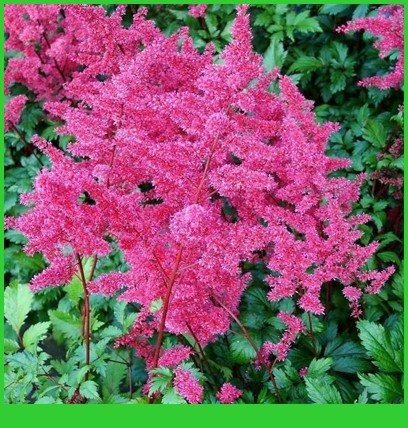

- Astilba "Vision in Red" is a plant with fluffy flowers of a dark crimson hue. The culture is undersized. Reaches a height of fifty centimeters, foliage with a bronze coating. Can grow in sun and shade.
- Astilba "Purperkerce" - blooms with inflorescences in the form of a pyramid of purple color with a lilac tint. The height of the culture is fifty centimeters. It adapts well to various climatic conditions. Differs in early flowering.


Astilba is a decoration for any garden. Such a plant gets along well with many cultures, which allows you to decorate the site with a variety of options.
Already from afar, bright red astilba inflorescences are visible, so many growers are happy to plant them. The growing popularity of this perennial flower is also facilitated by the fact that it can be grown under trees and near bushes. Since it is these areas that usually remain bare, because flowering plants need to be given a mostly sunny place.
Astilba is a herbaceous plant with an interesting inflorescence in the form of panicles of small flowers of pink, red or white color on a high stem and beautiful decoratively dissected leaves on brown cuttings. Thanks to the spreading foliage, it is a decoration of the garden not only during the flowering period (almost the entire July), but also during the rest of the year.
This plant is considered frost-resistant, as it most often grows in natural conditions in the mountains (up to 4800 m). Therefore, many flower growers say that astilba does not need to be prepared for wintering. Which is not entirely true. The activities necessary for her depend on her age and the climatic zone where she grows.
In this article, we will consider how to prepare Astilba for winter, taking into account the factors listed above.
Preparing Astilba for winter
If you want to get a strong bush, then caring for astilba for the winter must begin in the summer. To do this, in a young plant, the peduncle should be cut off as soon as it appears. Then you just need to regularly weed the soil around the bush to prevent the formation of a hard crust. This must be done very carefully so as not to damage the roots.
It will be necessary to cut off all the leaves of the young astilba for the winter when the first autumn frosts pass and the ground part turns black. This is usually done on the same level with the soil. Then it will be enough to make a hill 3-4 cm high above the hemp and mulch the planting site with a thin layer of peat or dry leaves. You can also use finely chopped bark or well-rotted manure for this.
In the next few years, caring for a healthy astilba bush will consist of pruning it for the winter under the root and mulching with the previously listed means. This is very important to keep the plant from freezing. After all, the growth of the rhizome occurs upward, which means that it gradually becomes bare and becomes vulnerable to frost.Also, if this is not done, then in the spring the plant will be weak, which means that it will bloom little and not for long.
At the age of 4-5 years, astilba needs not just mulching the soil for the winter, but a full-fledged shelter. For this, the traditional cutting of the stem and leaves is first carried out. Then a wooden frame is installed around it (it can be made of any materials). Fallen dry leaves are thrown inside it, and a non-woven material, such as spunbond or lutrasil, is pulled from above. In order to prevent water from entering the middle, which is the cause of the death of plants in winter, we cover this structure with plastic wrap and press it along the edges so that it is not blown away by the wind.
It is very important to make astilba as strong as possible before wintering, because it depends on this whether it will endure winter and early spring frosts. To further increase the plant's chances of survival, it is recommended to feed it in the fall. This can be done by introducing potash and phosphorus fertilizers into the soil (at the rate of 25 grams of the drug for each bush). You can also use organic fertilizers (eg manure). Due to its slow rate of decomposition in spring, the flower will receive additional nutrition in an accessible form, which will ensure a longer and more abundant flowering in summer.
Astilba is a herbaceous perennial that adorns any flower garden with its bright velvet inflorescences. In nature, it grows in mountainous regions with a monsoon climate, which makes it very unpretentious. Competent care in the fall and preparing the astilba for winter will help the plant survive the frosts and delight others in the coming season with lush inflorescences of various shades.
Pruning astilba in the fall
There are many varieties of this perennial, and they bloom at different times (from June to September).
Advice! It is not at all necessary to immediately remove the faded panicles at the end of the flowering of astilbe, they look very attractive even when dry, which means they can make your autumn garden even more colorful.
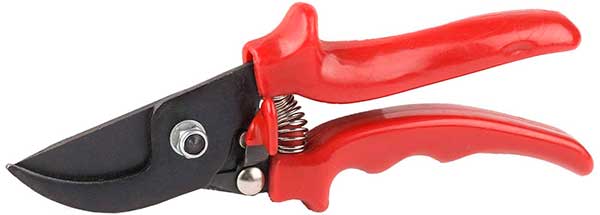

Before pruning, you should prepare the necessary equipment for this procedure. Usually, pruning of the stems is carried out with a garden pruner. In order not to expose the bushes to possible infection, before starting the procedure, the instrument is placed for half an hour in a pink solution of potassium permanganate. At the same time, in order to exclude the possibility of transferring infection from one plant to another, it is better to disinfect the pruner after cutting each specimen.
Why prune astilba in the fall
It is advisable to have time to trim the peduncles before the plant starts planting the seeds, since such a procedure is often useless (unless, of course, you want to collect seeds and propagate in this way), and the plant will spend its energy on it.
Another opinion! Some gardeners, on the contrary, think that dry inflorescences of faded astilbe spoil the aesthetic appearance of the garden. It is much better if the shrub is still green without dry panicles.
Therefore, most often, after flowering, astilbe is not completely cut off, but only those peduncles that have finished flowering are removed.
A little later, after the first frost, the rest of the above-ground part of the bush is cut off, because the cut perennial is easier to cover for the winter.
Reproduction of astilba
Astilba reproduces in three ways: division of rhizomes, seeds and germinating buds.
The most common way of reproduction of astilba is by dividing the rhizome. Each section should be at least 5 cm long and have from one to three growth buds. It is good if this division has adventitious roots. If you want to see this bush bloom in the fall, then divide it in the spring. Astilba can be transplanted at different times of the year, the main thing is to ensure abundant watering for several days after transplanting.
"Species" specimens are propagated by seeds.The seeds are very small, they set well, but they do not always ripen. If the seeds have matured, then in September they will need to be shaken out of the inflorescences. Having prepared in advance boxes with a nutrient mixture of sand and peat, sowing can begin in March. Seeds sprout 3-4 weeks after sowing and grow rather slowly. Only at the end of the year it will be possible to see a small rosette of leaves. If astilbes do not interfere with each other's growth, then is it necessary to replant them this season? Of course not. Better to transplant next spring to a previously prepared place. Plants grown from seeds will bloom only in the third year.
And finally, the third way: reproduction by the buds of renewal. This method can be used in early spring by cutting out the growth bud with part of the rhizome. This method is also called heel reproduction. You can keep the queen cell for reproduction. 1/3 of the mass of the entire bush can be divided without harm to it. Rooted in greenhouses in a soil similar to soil for sowing seeds, pouring it with a layer of 5-7 cm on ordinary fertile soil. It is better to plant astilba in a permanent place in the spring of next year. It will bloom in the same year.
There is another way - this is propagation by green cuttings in early spring, but it is not effective enough and therefore is rarely used.



